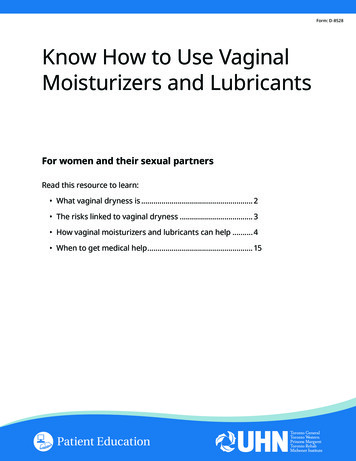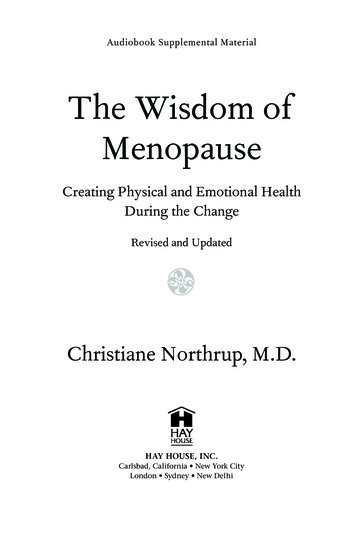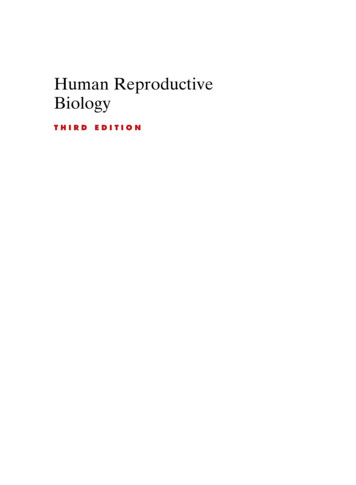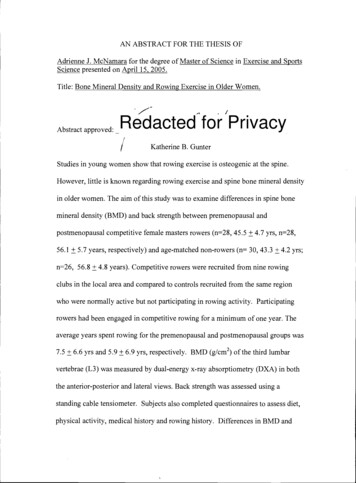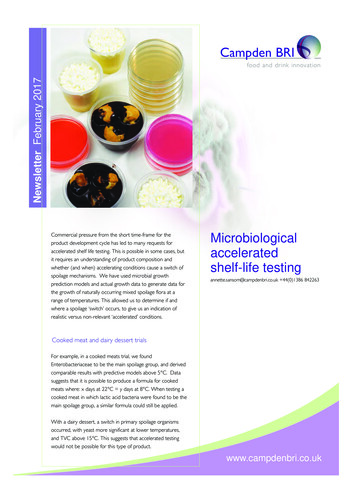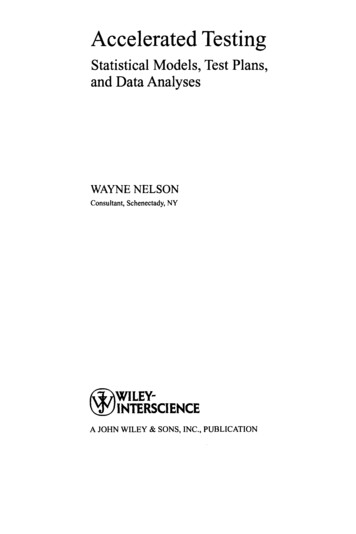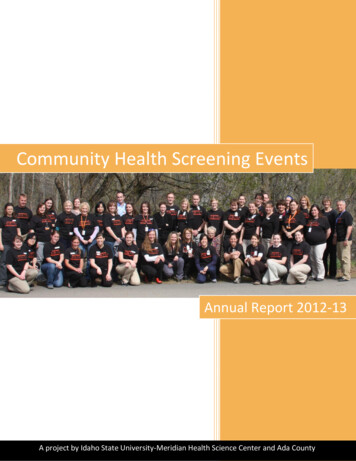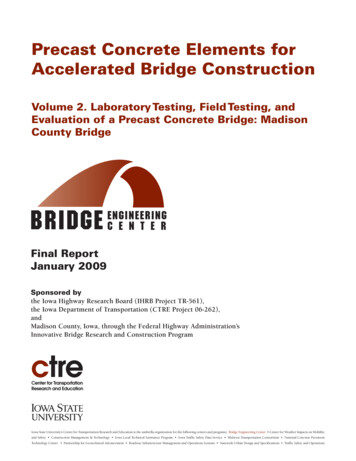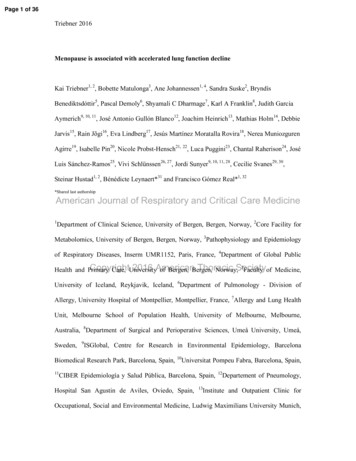
Transcription
Page 1 of 36Triebner 2016Menopause is associated with accelerated lung function declineKai Triebner1, 2, Bobette Matulonga3, Ane Johannessen1, 4, Sandra Suske2, BryndísBenediktsdóttir5, Pascal Demoly6, Shyamali C Dharmage7, Karl A Franklin8, Judith GarciaAymerich9, 10, 11, José Antonio Gullón Blanco12, Joachim Heinrich13, Mathias Holm14, DebbieJarvis15, Rain Jõgi16, Eva Lindberg17, Jesús Martínez Moratalla Rovira18, Nerea MuniozgurenAgirre19, Isabelle Pin20, Nicole Probst-Hensch21, 22, Luca Puggini23, Chantal Raherison24, JoséLuis Sánchez-Ramos25, Vivi Schlünssen26, 27, Jordi Sunyer9, 10, 11, 28, Cecilie Svanes29, 30,Steinar Hustad1, 2, Bénédicte Leynaert*31 and Francisco Gómez Real*1, 32*Shared last authorshipAmerican Journal of Respiratory and Critical Care Medicine1Department of Clinical Science, University of Bergen, Bergen, Norway, 2Core Facility forMetabolomics, University of Bergen, Bergen, Norway, 3Pathophysiology and Epidemiologyof Respiratory Diseases, Inserm UMR1152, Paris, France, 4Department of Global Public5Copyright2016 AmericanThoracicHealth and PrimaryCare, Universityof Bergen, Bergen,Norway,SocietyFaculty of Medicine,University of Iceland, Reykjavik, Iceland, 6Department of Pulmonology - Division ofAllergy, University Hospital of Montpellier, Montpellier, France, 7Allergy and Lung HealthUnit, Melbourne School of Population Health, University of Melbourne, Melbourne,Australia, 8Department of Surgical and Perioperative Sciences, Umeå University, Umeå,Sweden,9ISGlobal, Centre for Research in Environmental Epidemiology, BarcelonaBiomedical Research Park, Barcelona, Spain, 10Universitat Pompeu Fabra, Barcelona, Spain,11CIBER Epidemiología y Salud Pública, Barcelona, Spain,Hospital San Agustin de Aviles, Oviedo, Spain,12Departement of Pneumology,13Institute and Outpatient Clinic forOccupational, Social and Environmental Medicine, Ludwig Maximilians University Munich,
Page 2 of 36Triebner 2016Munich, Germany,14Department of Occupational and Environmental Medicine, Universityof Gothenburg, Göteborg, Sweden, 15Department of Respiratory Epidemiology, OccupationalMedicine and Public Health, Imperial College, London, United Kingdom,Lung Medicine, Tartu University Clinic, Tartu, Estonia,1716Department ofDepartment of Medical Sciences,18Lungmedicine and Allergology, Uppsala University, Uppsala, Sweden,Neumología, Servicio de Salud de Castilla – La Mancha, Albacete, Spain,19Servicio deEpidemiologia,20Salud Pública, Dep. Salud, Gobierno Vasco, Hospital , Galdakao, Spain,PneumologiePédiatrique, Antenne Pédiatrique du CIC, Centre Hospitalier Universitaire Grenoble Alpes,Grenoble, France,2221Swiss Tropical and Public Health Institute, Basel, Switzerland,Department of Public Health, University of Basel, Basel, Switzerland,Electronic Engineering, University of Ireland, Maynooth, Ireland,23Department of24U1219, BordeauxAmerican Journal of Respiratory and Critical Care MedicinePopulation Health Research Center, Bordeaux, France,of Huelva, Huelva, Spain,2625Department of Nursing, UniversityDepartment of Public Health, Aarhus University, Aarhus,Denmark, 27National Research Center for the Working Environment, Copenhagen, Denmark,28Hospital del Mar Medical Research Institute, Barcelona, Spain,29Department of2016 AmericanThoracicOccupational CopyrightMedicine, HaukelandUniversity Hospital,Bergen,SocietyNorway, 30Centre forInternational Health, University of Bergen, Bergen, Norway,31Team of Epidemiology,Inserm UMR1152, Paris, France, 32Department of Gynecology and Obstetrics, University ofBergen, Bergen, Norway;
Page 3 of 36Triebner 2016Corresponding authorKai Triebner, MSc.Department of Clinical ScienceUniversity of BergenJonas Lies veg 875021 BergenNorwayTelephone: 47 4503 1557E-mail: kai.triebner@uib.noContributorshipAmerican Journal of Respiratory and Critical Care MedicineKai Triebner:Principal author, conception and design of the work, acquisition, analysis, and interpretationof data, drafting the work and revising for important intellectual content;Copyright2016 AmericanBobette Matulonga,Ane Johannessen:Thoracic SocietyInterpretation of data and revising for important intellectual content;Sandra Suske, Steinar Hustad:Acquisition, analysis, and interpretation of data and revising for important intellectualcontent;Luca Puggini:Analysis and interpretation of data and revising for important intellectual content;
Page 4 of 36Triebner 2016Bryndís Benediktsdóttir, Pascal Demoly, Shyamali C Dharmage, Karl A Franklin, JudithGarcia Aymerich, José Antonio Gullón Blanco, Joachim Heinrich, Mathias Holm, DebbieJarvis, Rain Jõgi, Eva Lindberg, Jesús Martínez Moratalla Rovira, Nerea MuniozgurenAgirre, Isabelle Pin, Nicole Probst-Hensch, Chantal Raherison, José Luis Sánchez-Ramos,Vivi Schlünssen, Jordi Sunyer, Cecilie Svanes:Conception and design of the work, acquisition and interpretation of data and revising forimportant intellectual content;Bénédicte Leynaert, Francisco Gómez Real:Conception and design of the work, acquisition, analysis, and interpretation of data, draftingthe work and revising for important intellectual content;American Journal of Respiratory and Critical Care MedicineDeclaration of financial supportKai Triebner has received a PhD scholarship from the Norwegian Research Council(Application Number: ES515063 Project Number: 228174). The European CommissionCopyrightAmericanThoracicsupported ECRHS,as part of 2016the “Qualityof Life” program.Bodies Societyfunding the local studiesin ECRHS are listed in the online data supplement.Running headMenopause accelerates lung function declineDescriptor number2.03 Health Education/Disease Prevention/Patient Education
Page 5 of 36Triebner 2016Word count2898At a Glance CommentaryThe present study is the first to investigate the effect of menopause on lung function in alarge, longitudinal and population-based survey. We analyzed the decline of forced vitalcapacity and forced expiratory volume in one second as related to menopausal status. Thestudy population is a hormonally well-defined group of women, aggregated by latent classanalysis on measurements of follicle stimulating hormone and luteinizing hormone as well asquestionnaire data. Linear mixed effects models showed that postmenopausal women andwomen in the menopausal transition are associated with a steeper decline in lung function,American Journal of Respiratory and Critical Care Medicinebeyond the age related decline, compared to nonmenopausal women. Our findings arerelevant for clinical practice and health care professionals should be aware that womenundergoing the menopausal transition are at risk of accelerated lung function decline.CopyrightOnline data supplement2016 American Thoracic SocietyThis article has an online data supplement, which is accessible from this issue's table ofcontent online at www.atsjournals.org
Page 6 of 36Triebner et al1AbstractRationale: Menopause is associated with changes in sex hormones, which affect immunity,inflammation, and osteoporosis and may impair lung function. Lung function decline has notpreviously been investigated in relation to menopause.Objectives: To study whether lung function decline, assessed by forced vital capacity andforced expiratory volume in one second, is accelerated in women who undergo menopause.Methods: The population-based longitudinal European Community Respiratory HealthSurvey provided serum samples, spirometry and questionnaire data about respiratory andreproductive health from three study waves (N 1438). We measured follicle stimulatingAmerican Journal of Respiratory and Critical Care Medicinehormone and luteinizing hormone and added information on menstrual patterns, to determinemenopausal status using latent class analysis. Associations with lung function decline wereinvestigated using linear mixed effects models, adjusting for age, height, weight, packyears,current smoking, age at completed full-time education, spirometer and including study centerCopyrightas random effect.2016 American Thoracic SocietyMeasurements and Main Results: Menopausal status was associated with accelerated lungfunction decline. The adjusted mean forced vital capacity decline was increased by -10.2ml/yr (95% Confidence interval -13.1 to -7.2) in transitional women and -12.5 ml/yr (-16.2 to-8.9) in postmenopausal women, compared to women menstruating regularly. The adjustedmean forced expiratory volume in one second decline increased by -3.8 ml/yr (-6.3 to -2.9) intransitional women and -5.2 ml/yr (-8.3 to -2.0) in postmenopausal women.
Page 7 of 36Triebner et al2Conclusions: Lung function declined more rapidly among transitional and postmenopausalwomen, in particular for forced vital capacity, beyond the expected age change. Cliniciansshould be aware that respiratory health often deteriorates during reproductive aging.Key wordsLatent class analysis; lung function decline; menopause; reproductive aging; sex hormones;Word count abstract250Abbreviations usedAmerican Journal of Respiratory and Critical Care MedicineBLUP: Best Linear Unbiased PredictionBMI: Body Mass IndexCI: Confidence IntervalFEV1: Forced Expiratory Volume In One Second2016FSH: FollicleCopyrightStimulating HormoneFVC: Forced Vital CapacityLH: Luteinizing HormoneOBS: ObservationsSD: Standard DeviationAmerican Thoracic Society
Page 8 of 36Triebner et al3INTRODUCTIONThe non-reproductive phase of a woman’s life begins with menopause (1). Cessation ofmenstruations may be accompanied by lack of energy, hot flushes, vaginal discharge,insomnia, osteoporosis and an increased risk of developing chronic conditions like diabetesand cardiovascular disease (2-6). Menopause is associated with profound changes in theactivity of the hypothalamo-pituitary-gonadal axis: as 17β-estradiol production in the ovariesceases, follicle stimulating hormone (FSH) and luteinizing hormone (LH) concentrations rise(7, 8). Low levels of 17β-estradiol are associated with increased systemic inflammation andinflammation in the lungs (9-16). The inflammation markers C-reactive protein andInterleukin-6 are inversely associated with forced vital capacity (FVC) and forced expiratoryvolumein one second(FEV1of) (17,18). These findingstowardsCarea intCriticalMedicinebetween menopause and increased lung function decline. Given today’s life expectancy farbeyond the age of menopause, understanding how to maintain good health and quality of lifein later years is important (1, 19-22). The role of sex hormones in respiratory health isincreasingly acknowledged (23-32). However, potential changes in respiratory health asCopyright 2016 American Thoracic Societyrelated to reproductive aging in women are still poorly understood (23, 33, 34). A recentlongitudinal analysis of a large population based survey showed higher incidence of newonset asthma and increase in respiratory symptoms as related to menopause (28). Potentialchanges in lung function with menopause have only been addressed in cross-sectionalanalyses: One population-based study of women aged 45 to 55 years, not using hormonereplacement therapy, found lower lung function in postmenopausal women compared towomen who still had regular menstruations (27). A recent study from the UK Biobank foundan association between cessation of menstruation and lower lung function, whereas anotherstudy saw no independent effect of menopause on FVC and FEV1 levels (35, 36). It has beenreported that lifestyle factors such as smoking may be more detrimental after menopause,
Page 9 of 36Triebner et al4while some hormone replacement therapy regimens appear to be associated with higher lungfunction in postmenopausal women (37-39). Whether obesity impacts on respiratory health inmenopause is not known, although sex hormones and body fat mass are interrelated (40, 41)and effect modification of BMI on the role of hormone replacement therapy is suggested incross-sectional studies (42). The aim of the present study was to investigate the association ofmenopausal status with decline in lung function over a 20-year period, using data from alarge European, population-based cohort. Some of the results of this study have beenpreviously reported in the form of an abstract to the European Respiratory Society annualcongress (43).American Journal of Respiratory and Critical Care MedicineCopyright 2016 American Thoracic Society
Page 10 of 36Triebner et al5METHODSStudy populationThe European Respiratory Health Survey (ECRHS) is an international multicenter studyincluding three waves, ECRHS 1 in 1991-1994, ECRHS 2 in 1998-2002 and ECRHS 3 in2010-2012, and is described in detail at http://www.ecrhs.org. The age range at baseline was25 to 48 years and the median observation time for women participating in all three waveswas 19.7 (17.9 - 22.4) years. The present study includes 19 centers in Europe (see Table E1in the online data supplement). The examinations included an interviewer-led questionnaire,spirometry and serum sampling. At ECRHS 2 and 3 women additionally answeredstandardized questionnaires on women’s health. For 2484 women, serum samples fromECRHS 2 and/or 3 were analyzed for FSH and LH (see online data supplement). InclusionAmerican Journal of Respiratory and Critical Care Medicinecriteria are presented in Figure 1. Ethical approval was obtained from the appropriate ethicscommittee and each participant provided informed written consent.Figure 1. Study population with inclusion criteria (*height and packyears)Copyright 2016 American Thoracic SocietyClassification according to menopausal statusEvery woman contributed with up to three observations (ECRHS 1, 2 and/or 3, Nobs 3295).We attributed each observation separately to a menopausal status, at the same time as thepulmonary function tests were conducted. At baseline we included only nonmenopausalwomen, excluding women who retrospectively reported their last period more than one yearbefore baseline. To determine menopausal status at ECRHS 2 and 3 we performed latentclass analysis in order to identify subgroups within our population, based on menopauserelated factors such as hormone levels and presence and/or regularity of menstruations (44,45). Latent class analysis is commonly used in medical research to classify subjects byselected characteristics ( 2000 publications listed on www.PubMed.gov). The number of
Page 11 of 36Triebner et al6classes was restricted to three, retrospectively labeled: nonmenopausal, transitional andpostmenopausal. Observations were assigned class-memberships based on responseprobabilities (see Table E2 in the online data supplement). The algorithm, grouping the mostsimilar observations, was repeated 30 times with a maximum of 10.000 iterations. Theincluded categorical variables were FSH in quintiles, LH in quintiles and menstrual status asreported by participants (see Table E2 in the online data supplement). Each participant waspresent either in one, two or all three classes, representing the reproductive stage at differentwaves.OutcomesFVC and FEV1 were recorded following standardized methods (46, 47). The spirometers thatAmerican Journal of Respiratory and Critical Care Medicinewere used are presented in Table E1 in the online data supplement.Statistical analysisData of all three waves was modeled by linear mixed effects models, allowing for randomCopyright2016AmericanThoracicintercepts (48).By includingspirometricmeasurementsand an Societyinteraction term of themenopausal status with age, we determined the lung function decline defined as the slope ofchange in lung capacity, which can be interpreted as the mean annual decline [ml/yr]associated with each menopausal status. We adjusted for fixed effects of age, weight,packyears, current smoking and type of spirometer at each wave, as well as height at baselineand age at completed full time education as a socioeconomic proxy, which if missing (6.0%)was imputed as the population mean. Missing age (3.8%) and weight (9.4%) were included asage and weight at a different wave plus the mean increase during follow-up. The participant’sid number, nested in the respective study center, was accounted for as random effect.Stratified analyses were performed among never-smokers, ever-smokers and BMI categories
Page 12 of 36Triebner et al7according to the World Health Organization. To investigate whether results were driven by ahistory of asthma, or gynecological disorders such as polycystic ovary syndrome,endometriosis, surgical menopause (reported at ECRHS 2 or 3) or premature menopause ( 40years), we performed sensitivity analysis within the respective subgroups without theseconditions. We further tested potential heterogeneity between study centers and an alternativemodel, accounting for change in height over the study period. Analyses were performed usingR (Version 3.1.0, The R Foundation for Statistical Computing).American Journal of Respiratory and Critical Care MedicineCopyright 2016 American Thoracic Society
Page 13 of 36Triebner et al8RESULTSCharacteristics of the subjects at baseline are presented in Table 1. The class conditionalprobabilities and standard errors for the class membership, determined by latent classanalysis, can be found in Table E2 in the online data supplement.Table 1. Characteristics of the study population at baseline (n 13691)Age [yr]Height [m]Weight [kg]BMI [kg/m2]PackyearsCurrent smoking, n (%)Year of PFT1Observation time [yr]FVC [L]FEV1 [L]AmericanJournalDelta FVC2 [ml/yr]Delta FEV12 [ml/yr]ofMedian (5th, 95th percentile)36.2 (26.8, 45.0)1.64 (1.52, 1.75)61 (50, 85)22.6 (18.8, 31.2)1.0 (0.0, 24.0)438 (32)1992 (1991, 1993)19.7 (18.5, 21.0)3.85 (2.94, 4.80)3.19 (2.37, 3.96)Respiratory and Critical Care25.8 (2.4, 53.6)33.4 (10.7, 56.9)Medicine1Ntotal 1438, baseline observations for 69 women were incomplete and therefore excluded (follow-upobservations of these women were included)2Pulmonary function test3Annualized change over follow-upThe included 1438 women provided a total of 3295 complete observations (pulmonaryCopyright 2016 American Thoracic Societyfunction tests) including data on menopausal status and covariates (up to three observationsper woman). The nonmenopausal class included 60% (nobs 1992), the transitional class 18%(nobs 583) and the postmenopausal class 22% (nobs 720) of the observations. The mean agewas 39 years in the nonmenopausal, 53 years in the transitional and 56 years in thepostmenopausal class (Table 2). Weight and BMI were highest in the transitional class (Table2).
Page 14 of 36Triebner et al9Table 2. Characteristics of the observations by menopausal class, mean (SD)Age [yr]Height [m]Weight [kg]BMI [kg/m2]PackyearsCurrent smoking, n (%)FVC [L]FEV1 [L]FSH [IU/L]LH [IU/L]Nonmenopausal(nobs 1992)38.8 (6.8)1.64 (0.07)65.2 (12.6)24.2 (4.5)6.2 (10.3)581 (29)3.81 (0.58)3.11 (0.50)9.3 (9.9)5.8 (5.7)Transitional(nobs 583)52.8 (8.2)1.63 (0.07)71.7 (15.2)26.8 (5.4)9.2 (16.5)120 (21)3.41 (0.60)2.64 (0.53)56.8 (40.9)20.1 (10.0)Postmenopausal(nobs 720)55.7 (5.4)1.63 (0.07)69.3 (12.5)26.0 (4.4)9.5 (17.9)115 (16)3.35 (0.54)2.55 (0.45)146.9 (80.0)35.5 (11.0)Figures 2 and 3 show the best linear unbiased predictions (BLUP s) for FVC and FEV1 of thewhole population, obtained by adding together the population predictions (based on the fixedeffectsestimates)and the estimatedcontributions andof the Criticalrandom effects(48).MedicineBoth curvesAmericanJournalof RespiratoryCareshow a negative increase in slope when a large proportion of women enter the transitional ormenopausal stage.Figure 2. Best linear unbiased predictions for FVC of the study population (n 1438) according to the specified linearmixed effects model, including 95%CI and population distribution by menopausal class (The dotted line, as visual aidcontinues the initial slope).Copyright 2016 American Thoracic SocietyFigure 3. Best linear unbiased predictions for FEV1 of the study population (n 1438) according to the specified linearmixed effects model, including 95%CI and population distribution by menopausal class (The dotted line, as visual aidcontinues the initial slope).The mean age dependent lung function decline for all groups was -15.9 ml/yr (95% CI -18.2to -13.6) for FVC and -24.0 ml/yr (-25.9 to -22.0) for FEV1. The interaction term ofmenopausal status with age showed that the mean FVC decline was additionally increased by-10.2 ml/yr (-13.1 to -7.2) for women classified as transitional and -12.5 ml/yr (-16.2 to -8.9)for women classified as postmenopausal, compared to women menstruating regularly. Themean FEV1 decline additionally increased by -3.8 ml/yr (-6.3 to -2.9) for women classified astransitional and by -5.2 ml/yr (-8.3 to -2.0) for women classified as postmenopausal.
Page 15 of 36Triebner et al10Current smoking was significantly associated with FEV1 decline [-29.3 ml (-54.0 to -4.7)]compared to former smoking and lifelong non-smoking, whereas packyears weresignificantly associated with both FEV1 decline [-2.3 ml/packyear (-3.0 to -1.5)] and FVCdecline [-1.0 ml/packyear (-1.9 to -0.1)]. The results for other covariates of the primaryanalysis are presented in Tables E3 and E4 in the online data supplement.Analysis of FVC decline as related to menopause and stratified according to BMI at ECRHS3 showed a higher age related decline (Figure 4) and indicated a smaller menopause relateddecline with increasing BMI (pinteraction 0.01 for transitional women and pinteraction 0.001 forpostmenopausal women) (Figure 5). Ever smokers indicated a higher age related decline andhigher menopause related decline than never smokers. For FEV1 we observed a similar butless distinct pattern (Figure 4 and Figure 5).American Journal of Respiratory and Critical Care MedicineFigure 4. Age related lung function decline by smoking and BMI for the study population, ml/yrFigure 5. Menopause related lung function decline by smoking and BMI for the menopausal class, ml/yrThe sensitivity analysis showed that the results were not driven by a history of asthma, byCopyright 2016 American Thoracic Societygynecological disorders, by hypertension or cardiovascular disorders, or by surgical orpremature menopause (data not given). Results were consistent for individual centers withsufficient participants (Galdakao, Albacete, Grenoble, Paris, Reykjavik, Bergen, Umeå andUppsala).Height changed over the study period. The age related decline in height was -0.23 mm/yr(95% CI -0.38 to -0.08). Women in the menopausal transition had an additional decline of 0.62 mm/yr (-0.79 to -0.05) and the postmenopausal class an additional decline of -0.77mm/yr (-0.98 to -0.06). The alternative model accounting for change in height showed a 25%reduced, yet still significant, decline in FVC for both the transitional [-7.7 ml/yr (-10.6 to 4.7)] and the postmenopausal class [-9.0 ml/yr (-12.7 to -5.5)], compared to the
Page 16 of 36Triebner et al11nonmenopausal class. The decline for FEV1 was reduced by circa 50% and not significantafter such adjustment (transitional class: -2.1 ml/yr (-4.7 to 0.3), postmenopausal class: -2.6ml/yr (-5.8 to 0.5).American Journal of Respiratory and Critical Care MedicineCopyright 2016 American Thoracic Society
Page 17 of 36Triebner et al12DISCUSSIONThis population-based study of 1438 women aged 25-48 years from nine European countriesover 20 years with repeated spirometry, hormone measurements and questionnaire data,found that lung function declined more rapidly in women who were transitional orpostmenopausal, as compared to women who were nonmenopausal. To our knowledge, this isthe first longitudinal population-based study that investigates lung function decline in relationto menopause.The menopause related decline was more pronounced for FVC than for FEV1, which pointstowards a restrictive rather than an obstructive pattern. Stratified analyses and sensitivityanalyses revealed that these findings were very robust. Effect modification by BMI seemsAmerican Journal of Respiratory and Critical Care Medicineplausible, as circulating androgens are converted to estrogens in adipose tissue. Ever smokersshow a suggested steeper decline in both age and menopause related impairment of lungfunction, possibly because of a combined effect of smoking on the lungs and its antiestrogenic effects. Sensitivity analyses in women without a history of asthma, surgicalmenopause orCopyrightgynecological disorders,showed similarThoracicand statisticallysignificant results.2016 AmericanSocietyWe used latent class analysis to define the menopausal status rather than fixed cut-offs, asthis type of analysis accounts better for the underlying biology and the information gatheredfrom the participants. Clustering of the most similar observations forms the latent classes, andthe multivariate and repetitive nature of the classification process allows for a dynamicgrouping based on maximum likelihood criteria. We restricted classification to three classesas the data favored more classes by a marginally better fit, yet it supported a structure of twoclearly defined classes (nonmenopausal and postmenopausal), as well as a moreheterogeneous class representing different stages within the menopausal transition. Thetransitional class might include a minority of postmenopausal and nonmenopausal women.
Page 18 of 36Triebner et al13Hormone levels of women above 60 years who were still categorized as transitional are onaverage lower than in women categorized as postmenopausal. The trajectories of FSH overthe menopausal transition are not uniform across the population; e.g. women with a higherBMI or expressed sexuality are more likely to show a slower increase and lowerpostmenopausal level of FSH (49-51). These women are most likely postmenopausal,however hormonally they are more similar to the transitional class, as determined by thelatent class analysis (7, 8). The heterogeneity of the transitional class might diluteassociations slightly.Hormonal changes in menopause, linked to complex biological events might contribute to thedemonstrated acceleration in lung function decline with menopause. One possible mechanismisAmericansystemic inflammation,whichis associated andwith menopausalhypoestrogenismandJournal ofRespiratoryCritical CareMedicineimpaired lung function. The way 17β-estradiol affects inflammation depends strongly on thetype of inflammatory or immunogenic stimulus, the involved cell types, the target organ’sspecific microenvironment and metabolism, leading to different anti- and proinflammatoryeffects (10, 52). Animal models suggest that low levels of 17β-estradiol might amplifyCopyright 2016 American Thoracic Societyinflammation and higher levels might attenuate it (11, 12). In rats and mice, ,leukocytemigrationandlungmyeloperoxidase activity amongst others (13, 14). Ovariectomy is further associated withincreased levels of inflammatory markers, which decreased after 17β-estradiol substitution(13, 14). A comprehensive review concluded that in all available inflammatory models of thelung, 17β-estradiol was demonstrated to have an anti-inflammatory effect (10).Further, hypoestrogenism plays a critical role in osteoporosis, which results in reduced heightof the thoracic vertebrae which may mechanically reduce the expansion of the thoracic cageduring inspiration and place the diaphragm in a suboptimal position (53, 54). Our findings
Page 19 of 36Triebner et al14suggested that the accelerated decline related to menopause was in part explained byosteoporosis, as accounting for change in height attenuated the associations of menopausewith decline in FVC as well as FEV1.Strengths of the present study are the availability of repeatedly measured lung function andhormone measurements as well as interview/questionnaire data for large population samples.A unique window of opportunity was taken advantage of, as the study subjects were aged 2548 years at baseline and most women went through the age of the menopausal transitionduring the 20-year follow-up. Hormone measurements at two time points are a major strengthof this analysis, as well as the use of latent class analyses to define menopause based on bothhormone measurement and questionnaire information. The crude definition of menopause atbaseline,only basedon questionnairedata, is a andweaknessof the Carestudy thatmay haveAmericanJournalof RespiratoryCriticalMedicineintroduced minor non-differential error and thus attenuated true results. The outcomes of thestudy, objectively measured lung function parameters are a strength and spirometricmeasurement error is unlikely to be related to menopausal status. The change in spirometersbetween surveys is accounted for in the analyses, however, it is possible that a residual non-Copyright 2016 American Thoracic Societydifferential measurements error may have attenuated the true results. The multinational andmulti-centric design of the study allows for high external validity and the consistency acrossgeographic and cultural borders suggests biologic explanatory mechanism rather thanconfounding by sociocultural factors.ConclusionsThe present study shows that menopause was associated with an accelerated decline in lungfunction, beyond the expected age related decline. This was most pronounced for FVC. Theresults were consistent across subgroups and independent of smoking history. The effect sizefor FEV1 was comparable to smoking 20 cigarettes per day for two years, and for FVC to
Page 20 of 36Triebner et al15smoking 20 cigarettes per day for ten years. The mechanisms underlying the associationsbetween reproductive aging and respiratory health need to be further investigated. Futurestudies should address potential beneficial effects of hormone replacement therapy. Theresults from the present study should be taken into account, as they are highly relevant for thehealth and quality of life of a large and steadily incr
supported ECRHS, as part of the "Quality of Life" program. Bodies funding the local studies in ECRHS are listed in the online data supplement. Running head Menopause accelerates lung function decline Descriptor number 2.03 Health Education/Disease Prevention/Patient Education Page 4 of 36
